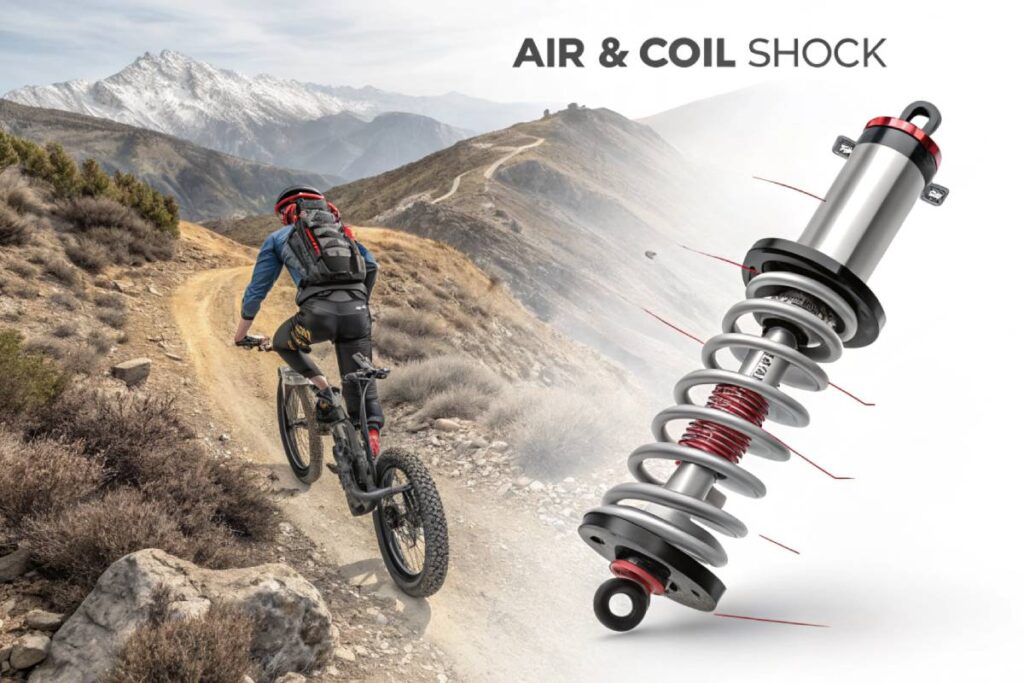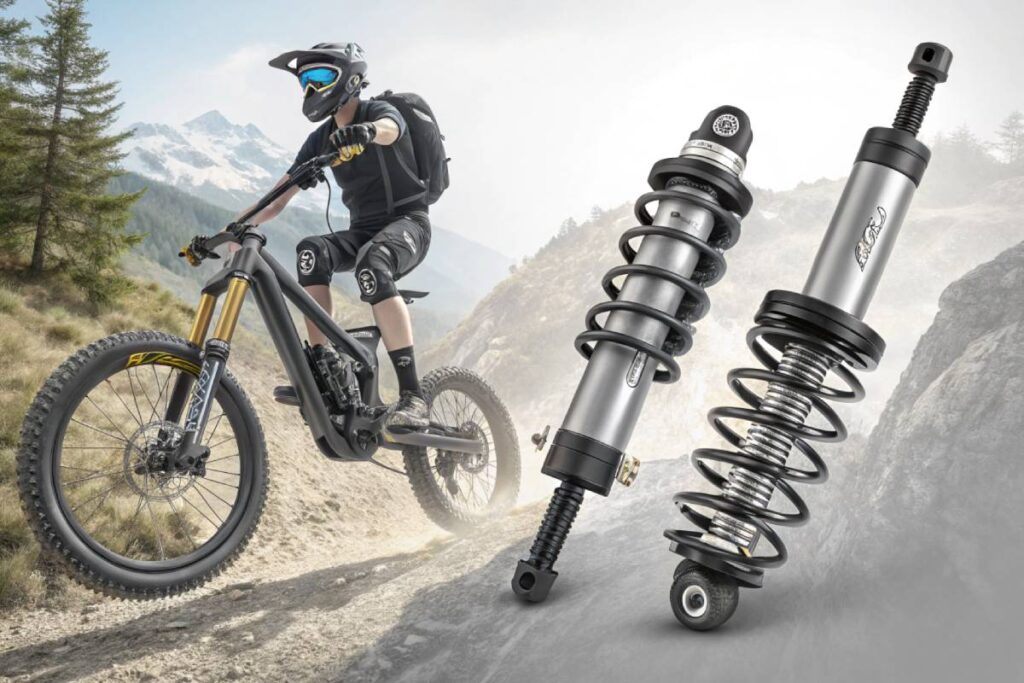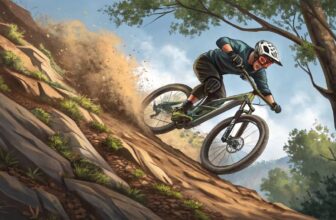Embarking on a mountain biking adventure is exhilarating, but what truly elevates your ride is the magic happening beneath the saddle—your rear shocks.
Imagine gliding effortlessly over rocky trails, mastering sharp turns, and conquering rugged terrains with unwavering control and comfort. Whether you’re a seasoned rider or just hitting the trails, understanding and optimizing your MTB rear shocks can transform your biking experience from bumpy to buttery smooth.
Let’s dive into the essential guide that will keep you ahead of the curve and fully equipped for every trail challenge.
Understanding Rear Shocks
Mountain biking can be a wild ride, and rear shocks are the unsung heroes behind the scenes. They keep your back end comfy and your wheels glued to the ground, bringing you more control as you tackle all sorts of trails.
Functionality of Rear Shocks
Rear shocks are like the Swiss Army knife for mountain bikes — they do a little bit of everything. Mainly, they cushion the blow from bumps or rocky trails and help the bike wheel bounce back smoothly to the ground. This little motion dance party means you can take sharp turns and nail those brakes without losing your grip. The experts over at BikeRadar are all about this movement magic, claiming it makes a big difference in rider comfort and confidence, especially for full-suspension rides.
Types of Rear Shocks
There are a bunch of different rear shocks out there, each giving you a different ride. Picking the right one keeps the good vibes rolling when you’re out on the trails. Here’s the lowdown on what might suit your biking style:
| Type of Rear Shock | Perks | Ideal For |
|---|---|---|
| Air Shocks | Lightweight, adjustable air pressure, excellent custom fit | Cross-country, trail riding |
| Coil Shocks | Steady dampening, tough, less finicky | Downhill, enduro |
Just like front suspension forks, rear shocks offer various tweaks. Ever seen a bike nerd fiddling with knobs? That’s preload, lockout, or damping adjustments they’re playing with (REI). Find more about choosing between coil vs. air shocks, right here.

Choosing your ideal shock type is like picking the right tool for the job. Air shocks are the go-to for those who love climbing and zipping around trails, thanks to their featherweight and tuning capabilities. Meanwhile, the Coil club prefers their sturdiness for tough, downhill escapades.
Wanna tweak your bike setup even more? A solid grasp of rear shock perks and some TLC will have you riding like a pro. Dive into our nifty guides on mountain bike maintenance and diy mountain bike repairs for some hands-on tips and tricks!
“Choosing the right rear shock is crucial for optimizing your ride. It’s not just about comfort, but also about how your bike handles the toughest trails,” says Sarah Johnson, Professional Mountain Biker.
Air vs. Coil Shocks
Picking the right rear shock for your mountain bike can be a game-changer, you gotta know the ropes between air and coil shocks. They each have their own set of perks, tailored to the rider’s groove and the trails you’re itching to ride.

Characteristics of Air Shocks
Air shocks are a hit among many mountain bikers, thanks to their tweakability and feather-like weight.
- Adjustability: With a simple shock pump, you can adjust air shocks like a pro. Set the right sag and feel of the suspension just how you dig it. Think of it as stirring your coffee to the perfect blend.
- Weight: Air shocks are lightweight champs. Perfect for trail and cross-country bikes where every ounce counts. Unlike carrying a bunch of useless shopping bags, you want your bike to feel light on your rides.
- Progressive Tweaks: Got them volume spacers? You can add or take them out to shift how the shock progresses. This lets you glide smoother mid-ride and prevents unintended, bone-jarring stops.
| Feature | Air Shocks |
|---|---|
| Adjustability | Tweak-friendly with a shock pump |
| Weight | Super lightweight |
| Progressiveness | Adjustable with volume spacers |
| Ideal For | Trail, XC, and all-mountain bikes |
Characteristics of Coil Shocks
Coil shocks are the trusty workhorses when the trail gets mean and rugged.
- Silky Smoothness: With coil shocks, your ride stays steady and smooth over gnarly paths. It’s like having butter on toast – consistent all over.
- Tough Cookie: These shocks handle the heat better, standing up to long, bumpy rides without getting pooped out.
- Rough ‘n Tough: Built for freeride and downhill madness, coil shocks are your go-to for absorbing shocks and staying solid.
| Feature | Coil Shocks |
|---|---|
| Consistency | Feels buttery smooth over rough terrain |
| Durability | Handles heat and tough trails like a champ |
| Terrain Handling | Perfect for downhill and freeride escapades |
| Ideal For | Downhill, tough enduro, and freeride bikes |
So, when it boils down to picking between air and coil shocks, it’s all about what floats your boat. Air shocks are your buddy if you crave light, fine-tuned rides. But if you’re seeking that steadfast performance in harsh terrains, coil shocks have your back.
If you’re curious to test different shocks on various trails, pop by our full-blown MTB suspension setup guide for more tips and tricks. Ride on!
“Air shocks offer unmatched versatility and weight savings, making them ideal for riders looking to fine-tune their suspension,” explains Mike Reynolds, Suspension Specialist at BikeRadar.
Factors to Consider
Picking the ideal rear shock for your mountain bike can transform your ride from a bumpy ride into a smooth, thrilling experience. Let’s break it down.
Rebound and Compression Adjustments
These adjustments are like your bike’s backstage crew, making sure every ride is a blockbuster. Rebound adjustment is all about controlling how your shock springs back when compressed – kind of like a trampoline but for your bike. It gives you a better grip and control.
Compression adjustment helps you manage how quickly your shock compresses, which enhances stability, so you’re not bouncing around like a kid in a bouncy castle. Together, they help you take on all kinds of terrain like a pro.
Rebound and Compression Adjustments
| Feature | Purpose | Benefit |
|---|---|---|
| Rebound Adjustment | Dictates how fast the shock extends | Better grip and control |
| Compression Adjustment | Dictates the speed of compression | More stability, more support |
| Lockout | Keeps the shock from moving too much | Less energy on those climbs |
| Preload Adjustment | Tailors the shock for your weight | Just-right suspension setup |
Go deeper into setting this up with our handy guide: mtb suspension setup.
Presence of Climbing Switch
The climbing switch is like having a secret weapon for hills. It’s a bit like finding an extra gear on a steep incline. Also known as a “lockout,” this feature stiffens or locks the shock so you don’t waste energy on uphill rides – meaning you’ve got more oomph left where it counts.
Climbing Switch Features
| Importance | Reason |
|---|---|
| Energy Efficiency | Keeps your energy on those calf-burning climbs |
| Stability | No more bobbing when you tackle hills |
| Convenience | Switch it up easily from open to locked modes |
External vs. Internal Reservoirs
When it comes to reservoirs, think of external like your air conditioner on a hot day – keeps things cool under pressure, perfect for gnarlier trails. Internal reservoirs, on the other hand, are like ditching your coat for a lighter jacket – they’re compact and great when you don’t need all that extra faff, ideal for cross-country or milder trails (REI).
Reservoir Types
| Type | Characteristics | Best For |
|---|---|---|
| External Reservoir | Stays cool under pressure, handles long haul well | Tough trails, lengthy descents |
| Internal Reservoir | Light and neat | XC, gentle hills |
Keeping these points in mind will steer you toward picking the perfect rear shock that suits your biking style to a T. Explore more of our stuff with mountain biking essentials and mtb gear ratios – trust us, it’ll be worth your while.
Testing Different Shocks
Checking out how rear shocks do their magic helps you find what fits best for your mountain biking adventures. This means taking them out on all sorts of tracks and seeing how they handle different challenges.
Testing on Different Trails
Taking rear shocks for a spin on varied tracks gives you a clearer picture of what they’re good at and where they might trip up. Based on the latest scoop, here’s what we’ve found:
| Trail Type | Coil Shock Performance | Air Shock Performance |
|---|---|---|
| Flow Trail | A tad slower | More bounce, better for jumps |
| Tech Trail | Quicker (1:19.41 average time) | Not as quick (1:20.60 average time) |
| Climbing | Almost no difference (0.11s) | Almost no difference (0.11s) |
- Flow Trails: These are about smooth rides with twists and jumps. When put to the test, coil shocks were just a smidge slower than air shocks. Yet, bikers found air shocks to be peppier, helping them hit jumps more effortlessly.
- Tech Trails: Tackling trails full of rocks and roots? That’s where coil shocks shine, being quicker on the clock with an average time of 1:19.41, while air shocks lagged at 1:20.60. This tiny 1.4% speed… gap shows that coil shocks keep cool and fast through bumpy parts.
- Climbing: Despite the rumors, coil shocks climb almost just as well as air shocks. The time difference? Just a blink-and-you’ll-miss-it 0.11 seconds, showing they’re nearly neck and neck when it comes to uphill battles.
Performance in Various Scenarios
How shocks behave can change depending on where and how you ride. Here’s what stood out:
- Jumping and Clearing Obstacles: Air shocks are a lively bunch, making them your go-to for tracks with lots of jumps and hurdles.
- Rough, Rocky Sections: When the terrain gets rough, coil shocks provide smoother rides and keep you on track at faster speeds.
- Climbing Efficiency: Both shocks are pretty close, proving coil shocks aren’t the laggards they were thought to be for climbing.
If you’re looking to fine-tune your mountain biking fun, knowing these details guides you in picking the best shock for you. For more specific tips on setting things up, have a look at our mountain bike suspension setup guide.
Keeping shocks in top form means regular check-ups. Our handy guide on mountain bike maintenance has all the tips you need. And, if you’re wondering how brakes play into your ride, peek at our mountain bike brakes comparison.
By taking rear shocks on different terrains, mountain bikers can choose wisely to amp up their ride, make their bikes adaptable, and enjoy every jot and title from the trail.
Importance of Rear Suspension
Impact on Mountain Bike Performance
Rear suspension can turbo-charge a mountain bike’s game by making bumps and thumps less jarring. It keeps you glued to the trail, smoothens your ride, and helps you zoom past rocks like you’re in a video game but without the cheat codes. Riders bouncing through rugged paths will love how the shocks keep their wheels hugging the ground, turning bone-shaking obstacles into barely-there ripples.
| Performance Aspect | Impact of Rear Suspension |
|---|---|
| Traction | Keeps the bike stuck to the ground like gum to a shoe |
| Comfort | Softens the blow, saving your spine from taking the hit |
| Control | Turns wobbles into smooth sailing |
| Efficiency | Glides over the rough stuff without turning energy into wasted effort |
With full-suspension bikes, both ends rise above the rocks. These beasts give you an edge on trails, clocking in quicker laps than those stubbornly stiff hardtails. In fact, on a 5 km route, riders experience a 2-minute lap time save. On flat stretches, though, it’s like the bike’s having an energy drink while you’re sipping decaf – the bounce might munch on some of your power for speed.
Sure, the rear suspension makes rugged rides easier, but they can sometimes water down your razor-sharp handling. They’re often beefier, adding some extra pounds compared to more straightforward hardtails, making tuning them as tricky as solving a jigsaw puzzle.
Versatility in Riding Styles
Rear suspension opens the doors to a buffet of biking styles. It’s a chameleon, adapting to whatever adventure you’re up for and the hurdles you expect along the ride. Here’s how rear suspension proves its worth in various scenarios:
| Riding Style | Benefit of Rear Suspension |
|---|---|
| Cross-Country (XC) | Makes long rides feel like short strolls with fewer ouches |
| Trail Riding | Grabs the ground like it’s its best friend, never letting go |
| Enduro | Soaks up shocks like a sponge, keeping descents smoother than a roller coaster ride |
| Downhill | Matches speed with cushion, ensuring blazing hikes don’t rattle your bones |
Cross-country riders can pedal through miles of mixed terrain without feeling like they went ten rounds in the ring. Trail enthusiasts find their rides calm and collected even on unpredictable paths. Those who lean into Enduro or Downhill lean heavily on the ear suspension, treating steep drops like gentle slides.
Evaluating how rear suspension ticks all the boxes across these styles can supercharge your biking experience. Dig into our mtb suspension setup tips to fine-tune your ride. For more nuggets on mountain biking essentials and mtb trail ratings, our guides spill the beans.
Maintenance Guide
Recommended Service Intervals
Keeping your mountain bike (MTB) rear shock spruced up is the ticket to smoother rides and lasting gear. Each brand has its own advice for service times, but here’s a cheat sheet to keep things rolling:
RockShox suggests:
- Air Can Spruce Up: Every 50 hours of riding
- Damper and Air Can Tune-Up: Every 100 hours (for all shocks except Deluxe and Super Deluxe)
- Deluxe and Super Deluxe Shocks: Damper and air can every 200 hours
Fox says:
- Go The Whole Hog: Every 125 hours of riding, with damper and air checked
Öhlins advises:
- Full Service: Every 100 riding hours, damper and air can be included
| Brand | Air Can Service (Hours) | Full Shock Service (Hours) |
|---|---|---|
| RockShox | 50 | 100 (200 for Deluxe & Super Deluxe) |
| Fox | N/A | 125 |
| Öhlins | N/A | 100 |
Jotting down these timings keeps your rear shocks from hiccups. For more wisdom and handy tips, peek at our mountain bike maintenance advice.
Basic DIY Shock Servicing
Sure, some rear shock stuff begs for the pros, but a dab of DIY doesn’t hurt. These tasks usually involve air can service, freshening up your shock’s mojo between big tunes.
Tools and Supplies Needed
- Shock pump
- Suspension fluid
- Clean rags
- Simple toolkit (hex keys, torque wrench)
Steps for Basic Air Can Service
- Let the Air Out: Use a shock pump to deflate the shock.
- Take Apart the Shock: Detach the shock from your bike and pop open the air can as per the manual.
- Clean Slack: Wipe all parts with a rag and check for wear and tear.
- Add Some Lube: Smear the right suspension fluid on the moving pieces.
- Put it Back Together: Reassemble the shock carefully, making sure everything’s snug.
- Pump it Up: Use a shock pump to bring the air can back to the magic number.
Note, that sprucing up an X2 shock often means a full overhaul, needing a nitrogen fill and special gadgets. Best to let the wizards handle that.
For more DIY bike hacks and upkeep tips, hop on over to our basic DIY mountain bike repairs page.
Stick to these service intervals and do-what-you-can tactics to keep your MTB rear shocks in shape for any trail. When in doubt about a task, calling in the pros is always smart.
Upgrading Rear Shocks
Giving your mountain bike a boost by swapping out the rear shocks can really level up your trail experience. We’re talking smoother rides, better performance, and just a whole lot more fun. But hold up—before you grab those wrenches, taking a minute to wrap your head around shock sizing and getting the right fit is key.
Understanding Shock Sizing
Shock sizing might sound like a complicated math problem, but it breaks down to two main numbers: how far apart the mounting holes are (eye-to-eye length) and how much the shock squeezes when you’re riding (stroke length).
| Measurement | Description |
|---|---|
| Eye-to-Eye Length | Space from one mounting hole to the other |
| Stroke Length | How much the shock hugs up when you hit rough patches |
Get these measurements spot on, and you’ll make sure your new shock plays nice with your bike’s frame (Worldwide Cyclery). Even bikes with similar styles might have different stroke lengths, so checking your bike’s manual or website for the nitty-gritty details helps you keep things running smoothly and safely.
Ensuring Compatibility
Compatibility ain’t just about those measurements though. You’ve also gotta think about the gear you’re working with, the type of shock, and how you plan to ride. Here’s what to keep in mind:
- Mounting Hardware: Your bike has its own way of doing things when it comes to fittings. Make sure your bike’s new shock bushings and reducers are up to speed with your bike’s setup.
- Shock Type: Air or coil—which one will it be? Each has pros and cons depending on what weighs more on your decision scale and the way you ride. Catch the breeze with air shocks or go hardcore with coil shocks? Check out our pointers over at air shocks and coil shocks.
- Intended Use: Take stock of your riding flavor—cross-country, trail, enduro, or downhill—and pick a shock that’s got the chops to keep up.
Internal links:
- Get a grip on the perfect frame fit for mountain bike frame sizes.
- Want to tweak your shock setup? See our mtb suspension setup.
- Keep your ride rolling smoothly with regular check-ins and tips for mountain bike maintenance and daily mountain bike repairs.
Stick to these key points, and you’ll have your shiny new rear shocks working in harmony with your bike, making those gnarly trails feel like a dream.
Comparing Coil and Air Shocks
Picking the perfect rear shock for your mountain bike can turbocharge how you ride. Here, we’ll break down the nuts and bolts (not literally, we promise) of coil and air shocks, and spill the beans on what makes each one tick for different biking adventures.
Characteristics and Preferences
Grasp the main differences between coil and air shocks to make savvy choices about your ride.
Coil Shocks:
- Consistency Superstars: Provide rock-solid damping, especially when you’re blazing down long descents, making them the go-to choice for downhill warriors and enduro shredders.
- Smooth Operators: Extra plush in the early stages of soaking up bumps. You get butter-smooth, predictable rides.
- Cool Runnings: Keep it chill with little heat build-up, ensuring they perform like champs on challenging trails.
Air Shocks:
- Light as a Feather: Typically weighs less than coil shocks, which means a nimbler bike for those twisty tracks.
- Tweak-Friendly: A quick pump adjustment and you’re ready to roll. Volume spacers add a dash of progressiveness to your ride.
- All-Rounder: Fit for a variety of bikes—from trail to enduro—providing comfort without harshness when the going gets rough.
Here’s a quick comparison chart to fuel your decision-making:
| Feature | Coil Shocks | Air Shocks |
|---|---|---|
| Weight | Heavier than a stack of pancakes | Featherlight, like a paper airplane |
| Adjustability | Not too flexible | A breeze to tweak with a shock pump |
| Suitable Riding Style | Downhill, Enduro | Trail, Enduro |
| Terrain Handling | Keeps it real on tough trails | Aces on varied ground |
| Heat Build-Up | Stays cool under pressure | Prone to heating up more than a summer BBQ |
Pros and Cons of Each Type
Each shock has its perks and downsides depending on your riding style and the trails you love to tackle.
| Pros of Coil Shocks | Cons of Coil Shocks |
|---|---|
| Super sensitive to small bumps for smooth rides | Heavier than air shocks, not great for lightweights |
| Reliable tireless performance on big descents | Not as adjustable for diverse terrains |
| Stays chill under pressure | Tricky to tweak for various rider weights |
| Pros of Air Shocks | Cons of Air Shocks |
|---|---|
| Lightweight—turns your bike into a nimble machine | Can get toasty on nonstop rough rides |
| Simple to adjust for weight and preferences | May not be as comfy in initial stages of travel |
| Handles a medley of riding styles | Needs more regular TLC to keep peak performance |
Hungry for more info on what impacts mountain bike performance? Check out our guides on mountain biking essentials and MTB suspension setup.
No matter if you’re team coil or team air, knowing the scoop on these shocks can supercharge your ride, making sure your suspension is dialed in for your style and those gnarly trails you love to conquer.
Conclusion
In the thrilling world of mountain biking, your rear shocks play a pivotal role in defining your ride’s comfort, control, and overall performance.
From choosing between the lightweight versatility of air shocks and the rugged reliability of coil shocks to mastering adjustments for rebound and compression, every decision shapes your trail experience.
Remember to maintain your shocks regularly and consider upgrades that align with your riding style and terrain preferences.
With the right rear suspension setup, you’ll navigate every trail with confidence and enjoy every twist and turn to the fullest. Gear up, tune your shocks, and ride on with unstoppable momentum!
Frequently Asked Questions (FAQs)
What is the main function of a mountain bike rear shock?
The rear shock absorbs impacts from rough terrain, improves ride comfort, and enhances control by keeping the wheels in contact with the ground.
How do I choose between air and coil rear shocks?
Choose air shocks for lightweight, adjustable performance ideal for cross-country and trail riding. Opt for coil shocks for durability and consistent performance on downhill and enduro trails.
How often should I service my rear shocks?
Service intervals vary by brand, but generally, air shocks should be serviced every 50-200 hours and coil shocks every 100-200 hours, depending on usage and manufacturer recommendations.
Can I adjust my rear shocks for different trail conditions?
Yes, most rear shocks allow adjustments for rebound, compression, and sometimes lockout features to tailor performance to specific trail conditions and riding styles.
What accessories can enhance my mountain bike’s rear shock performance?
Essential accessories include high-quality shock pumps, suspension tuning kits, protective shock covers, and maintenance tools like hex keys and torque wrenches.
Are rear shocks compatible across all mountain bike brands?
Compatibility depends on the bike’s frame and shock specifications. Always check the eye-to-eye and stroke lengths, as well as mounting hardware, to ensure compatibility.
What are the benefits of having a lockout feature on my rear shock?
A lockout feature allows you to stiffen the rear shock for efficient climbing and reduce energy loss, enhancing performance on uphill sections.




